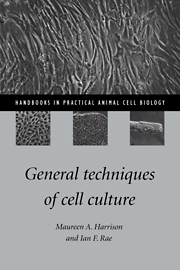4 - Serum
Published online by Cambridge University Press: 02 February 2010
Summary
Since the early days of cell culture technology, serum has been used as an important component in media for growing animal cells. It remains the principal supplement to increase the effectiveness of chemically defined media and contains most, if not all, of the growth factors and hormones that cells require for their growth. It is wide practice to use varying amounts of serum (up to 20%) to make up for small qualitative deficiencies in synthetic media.
Serum-free medium
In the early 1970s it was suggested that serum proteins acted mostly as carriers for low molecular weight hormones or growth factors and, if these could be provided in the medium, the presence of serum would not be necessary. In recent years many excellent serum-free media have been brought on to the market, which have proved this hypothesis. However, these have two disadvantages in the average laboratory set-up: (a) expense and (b) it is apparent that each cell line may require a different set of growth factors and base medium for growth. In a situation where one cell line is being grown on a large scale and deficiencies of particular components may be monitored on a regular basis and compensated for, serum-free media are useful, but where the researcher may be growing different cell lines the convenience of using serum cannot be overestimated.
Most serum-free media may be purchased as a complete package (either in liquid or powder form) and will contain a variety of amino acids, vitamins and inorganic salts plus one or more supplements to replace serum, e.g. bovine serum albumin, transferrin, insulin, epidermal growth factor, bovine pituitary extract, etc.
- Type
- Chapter
- Information
- General Techniques of Cell Culture , pp. 60 - 68Publisher: Cambridge University PressPrint publication year: 1997

